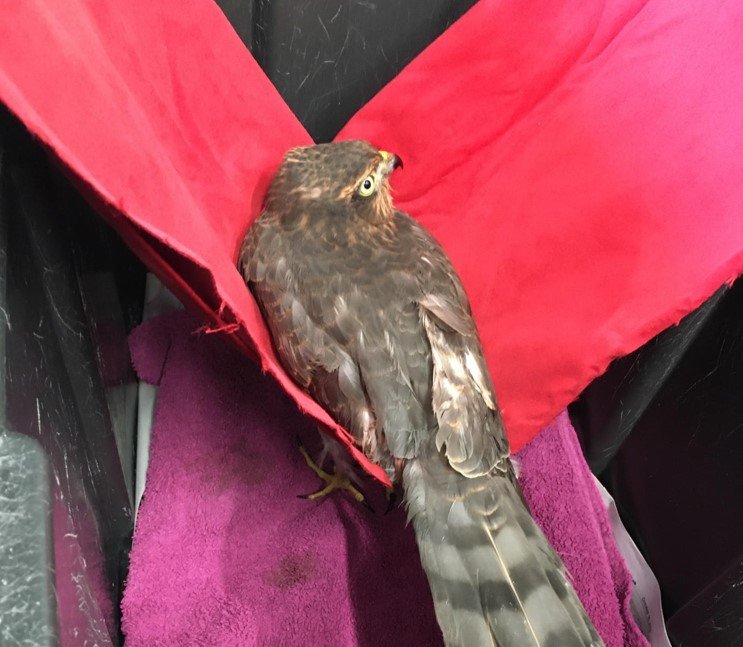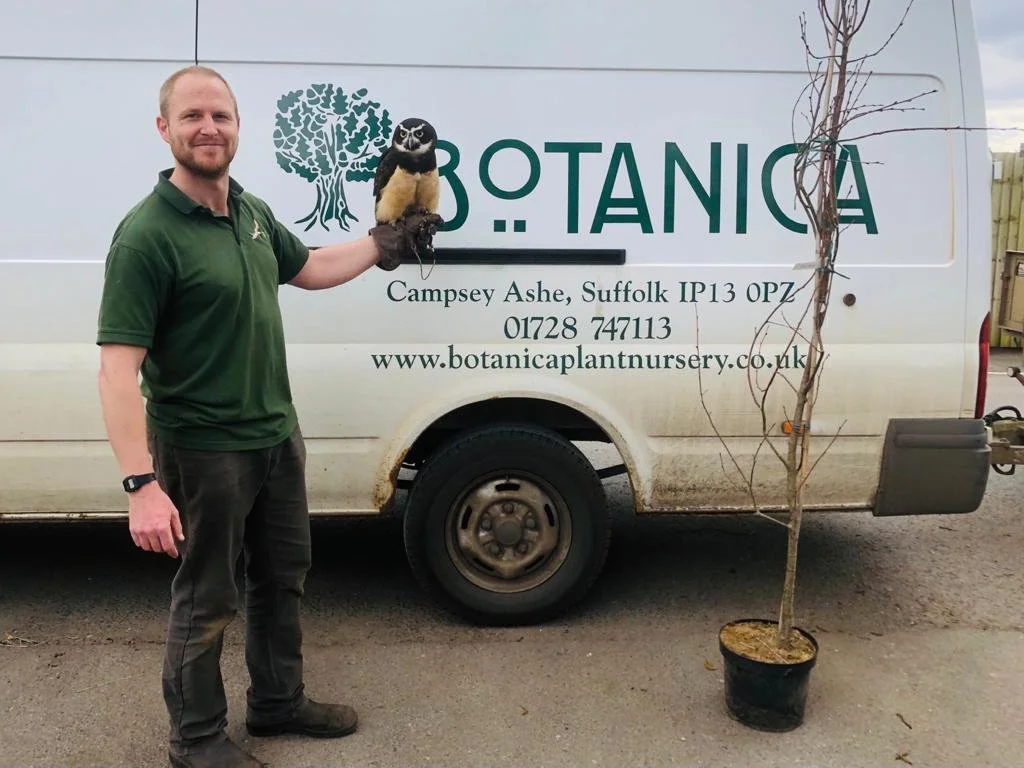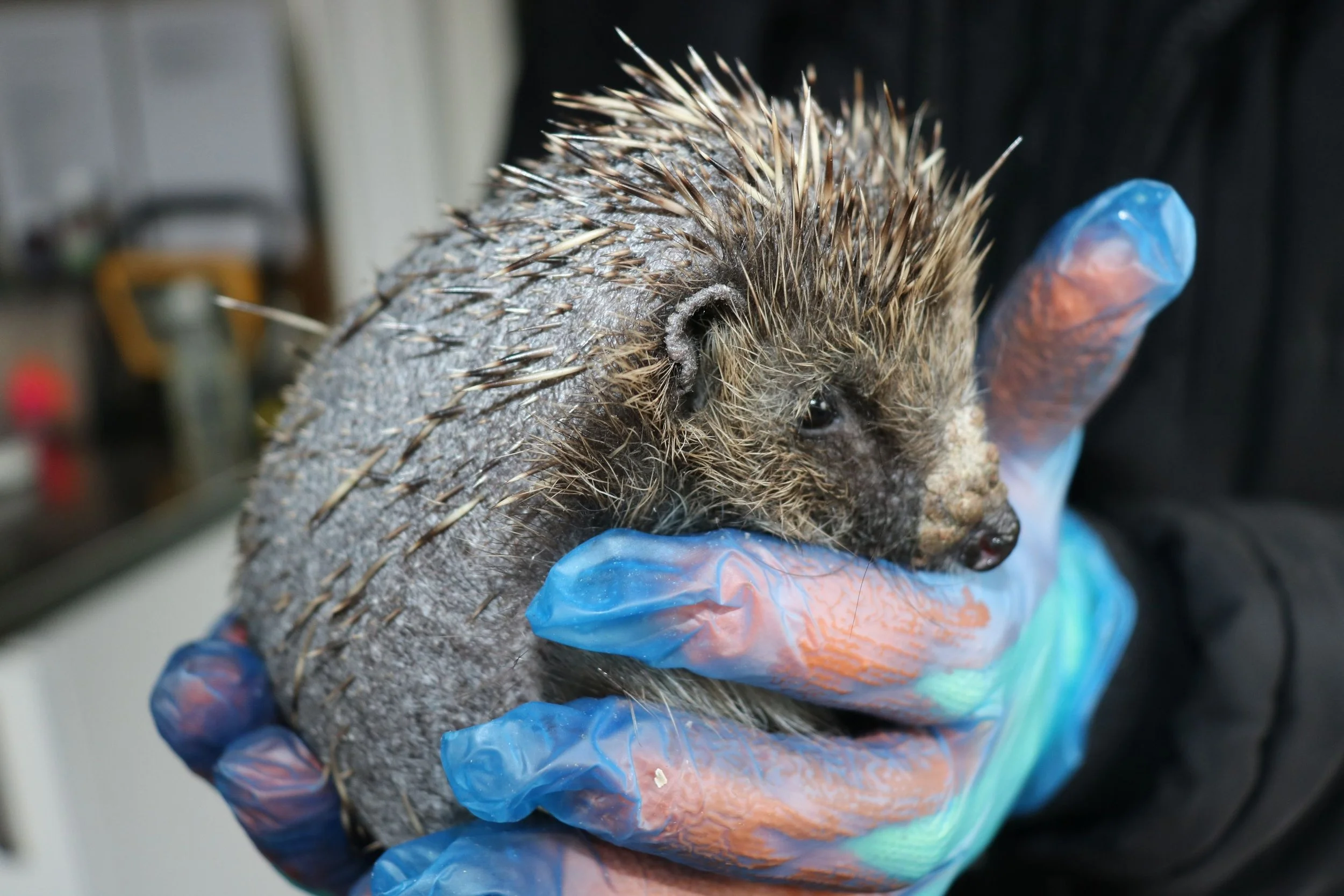As we approach the end of 2021, we thought we should review some of the key stories from the past twelve months.
We are forever grateful to our supporters, both local and further afield, who have continued to support us throughout the past twelve months. By sponsoring our birds for yourselves, friends and family, making donations to our appeals, purchasing items from our Wishlist, nominating us for grants and awards, sharing our posts on social media and visiting us in person, you are the reason we can continue to do what we do, so THANK YOU!
January
We started the year in lockdown, due to the double whammy of Covid and Avian Influenza.
The hospital saw a few cases, including this Sparrowhawk who had flown into a window and was unable to stand. She had swelling on her spine, so the team fashioned a sling to support her body weight while she was given food and medication. After a week or two she was supporting herself and transferred into an aviary so we could monitor her for any long term damage. Once assessed by our vet, she was deemed ready for release again.
Sparrowhawk in a sling to support her weight
February
February started COLD and we had several Snow Days where staff and volunteers from further afield were unable to get in. Thankfully, some of our staff live locally and were able to attend to the needs of our birds, animals and care for our Raptor Hospital patients too.
Keeper Beckie trudging through the snow to look after the animals.
Keeper Nick clearing snow from the doorway to the Falconers Hut.
Ruby, our Rüppells Griffon Vulture not enjoying the snow!
We had an interesting story when a pair of Kestrels were found inside a holiday property over Valentines weekend. They must have gone down the chimney thinking it was a suitable place to build a nest, but ended up locked inside the bedroom until the owner found them. The birds, named Romeo and Juliet, were dehydrated, but otherwise in good condition and after a few days in the Hospital they were returned to the garden of the property, where a nestbox had been installed for them to use.
Romeo, the male Kestrel just before release
While we were in Lockdown, some of our staff took the opportunity to train as Dementia Friends, to better support any visitors who require some additional help.
Catherine, one of our Shop staff and Susan our Education Officer are now Dementia Friends
March
Two Barn Owls were released in March, following long stays in the Raptor Hospital. Sticky was found stuck to a glue trap, which damaged her feathers so much that she was with us for over 18 months while she replaced her plumage. Holewing spent 10 months with us after being found stuck on a barbed wire fence. The metal had punctured his wing and this took some time to repair, then regain muscle fitness. The two were paired together for release, as Holewing was an older bird and Sticky was a youngster. These two birds were the first to be ringed in recent years before their release. By ringing rehab birds, we have a chance of finding out if our releases are successful, as we hope that these birds will be found breeding in a nestbox somewhere local in future years.
Our Education Officer Susan (who is also a bird ringer) measuring the wing length of one of the Barn Owls while ringing.
March also saw the completion of our major winter building project, as our new breeding block was finished. This off show block of aviaries allows our birds some peace and quiet away from visitors. We also took advantage of us still being closed to work on some of the older aviaries. Mir, our Steppe Eagle, is an original resident, and her aviary was looking a bit tired, so she was temporarily relocated while we replaced the mesh and built up one side to provide her with a bit more shelter from the weather.
One of our original aviaries got a make over while we were closed to visitors.
To help furnish the new aviaries, we were delighted to receive some native trees and shrubs donated by Botanica Plant Nursery in Campsey Ashe and Sandy Lane Nursery in Wattisfield, as well as some cut timber from local tree surgeons, Special Branch Tree Services.
Rufus with Cecil our Spectacled Owl, inspecting one of the new donated trees.
Large trunks like this make perfect perches in our aviaries!
April
As Covid restrictions were lifted, the Hospital saw a massive increase in the number of birds brought in after vehicle collisions. This included a Kestrel, Tawny Owl, Little Owl and a couple of Barn Owls all within a few days of eachother. Interestingly, one of the Barn Owls was wearing a metal ring on his leg, which allowed us to find out where he’d come from. He’d been ringed as a chick in 2012 near Boxford, making him almost 9 years old, earning him the nickname “Grandad Owl”. Thankfully, these birds all recovered from their injuries and were released after a short stay in the Hospital.
One of the Tawny Owls with eye damage following a collision with a vehicle
We used the services of our specialist avian vet Dr Elliot Simpson from Aquila Veterinary Services to check that all of our Hospital Birds are in good health before release. In April, he performed surgery on a Kestrel which we named Cowlick, as she was found being licked by cows on the floor of a barn. Unfortunately, this bird had an infection in her foot, which didn’t clear up after medication so Elliott had to operate to remove the infected tissue. After a few weeks under observation, she was deemed fit for release and returned back to the farm where she had been found.
We were pleased to be allowed to reopen to visitors following months of lockdown. Our staff, volunteers and birds had certainly missed having visitors, and with the weather improving, our displays became the focus of our activities each day. For some of our younger birds, this was their first experience of having an audience!
Head Falconer Rufus with Boris, our Lockdown Ashy-faced Owl… he soon got used to having an audience and by the end of the summer was delighting our visitors with his flying!
May
May saw our Education Team return to face to face teaching, with several outreach visits to local schools and youth groups. Susan was ably assisted on these visits by Bethany as they delivered our All About Owls session, Pellet Detectives activity and read a number of popular owl-themed children’s books.
Susan and Bethany delivering a session to children at The Hive
Another visit from Dr Elliott Simpson, this time to treat a Buzzard which had a case of frounce, a yeast infection which causes difficulty swallowing.
Dr Elliott Simpson checking the condition of a Buzzard that was brought in with frounce.
June
In June, we were awarded the Learning Outside The Classroom Quality Badge, to recognise our commitment to providing a safe educational experience for schools and groups visiting us at the Centre.
We also took on two new Trainees, Dolly and Jade. They were both volunteers prior to gaining employment with us, and have become valuable members of the team, helping with all aspects of our work, including training birds, helping with the Raptor Hospital and school bookings. We also celebrated National Volunteers Week with social media posts about some of our Volunteers.
Volunteer Sarah raking the Meerkat enclosure, while they supervise!
The first batch of young Owls were released in June, as three Tawny Owls found separately were put into our hack pen near where one of them was found. Although initially reluctant to leave, by the morning all three had vacated but were seen in the area for a few weeks following their release.
The three Tawny Owlets when they first arrived
July
A different species of young Owl came to us in July, in the shape of Little Owls. Christian Bale, as he was named, had unfortunately got himself tangled up in baler twine around a bale of hay, and had been transported from the field to the farm yard before being found. Thankfully, there was no lasting damage and the next day two more were brought in, having been found abandoned locally and covered in fly eggs and maggots. Before the end of the week, a fourth Little Owl arrived, who was found out in the open, and we suspect that he was stolen from the nest by a stoat or weasel, who was disturbed and dropped him in the middle of the field. Once these babies had been assessed and we were sure they would all be ok, they were released locally in someone’s garden, where they could be provided with food for as long as was necessary for them to disperse.
Little Owlets in the Hack Pen ready for release
With the start of the Summer holidays, visitor numbers soared. We operated a pre-booking system to have some control on numbers and this was well received by visitors, some of whom were still understandably nervous about being out and about following months of isolation. Our Admin staff did a great job of dealing with the bookings and welcomed everyone to the Sanctuary with a big smile, even if they were hidden by masks. Our staff and volunteers outside worked hard to ensure that the whole Sanctuary was kept in tip-top condition and to remind visitors of the social distancing rules.
Incoming! Cecil our Spectacled Owl didn’t adhere to social distancing when flying low over the audience’s heads!
Rafiki, our African Spotted Eagle Owl, wowing the crowds during our popular flying displays
Jack/ Rose, one of our Hooded Vultures, demonstrating just how beautiful Vultures can be1
August
Our popular Photography days with wildlife photographer Paul Sawer ran throughout the summer, and were blessed with good weather.
As the good weather continued throughout the summer holidays, we introduced some new elements to our flying displays, including a Food Chain game which gets the whole audience participating, even if they don’t volunteer to go up the front!
Falconers Rob and Tim leading the audience in our Food Chain game.
Our Hack Pen has been put to good use this year, and in August it was relocated to another area to avoid over-populating the immediate area with released birds. The first residents at the new location was a group of four Tawny Owls, two adults who had been with us for some time and two juveniles who had been placed into the adults care to avoid imprinting. Before release, these birds were ringed so that we might hear where they end up if they are found at a later date.
Farmer Sam with his family and one of the Tawny Owls about to go into the Hack Pen.
September
The start of September saw the return of our British Sign Language Day. Whilst we always support those visitors who require additional support to enjoy a visit to us, on this day all of our talks and displays are accompanied by a BSL interpreter.
Natalie, our BSL interpreter, signing for the deaf visitors while Bramble flies past.
We had a number of patients in the Raptor Hospital in September, which required some specialist advice from Dr Elliott Simpson. This included a window collision Sparrowhawk which had concussion, a Little Owl with a mysterious infection and a young Kestrel which for some unknown reason, won’t fly!
Jess holding a Sparrowhawk in the Raptor Hospital while Dr Elliot Simpson gives it a check over.
September saw a number of Buzzards brought into the Hospital, which gave us an opportunity to do some ringing training before they were released.
Dr Hugh Hanmer from the British Trust for Ornithology taking some measurements from the Buzzard while it was being ringed under licence.
Trainee Jade assisted Education Officer Susan at an all day event in Bury St Edmunds. Public engagement is an important skill for trainees to learn and Jade was a natural at talking to all the young visitors to our stall and answering their questions about our birds.
Trainee Jade with Auckland, meeting young people at an event in Bury St Edmunds.
We also welcomed a team from AXA, who came in to help us for the day. They helped Gary, from our Maintenance team, rebuild the bird hide in the Woodland Walk.
The team from AXA with Gary, one of our Maintenance team, having completed their team building volunteer day.
October
In October, we celebrated World Postcard Day with our Meerkats, who received postcards from all around the world!
One of our Meerkats reading a postcard from the USA
Due to being over subscribed during the summer holidays, we ran some additional dates for our Young Falconers Course over the half term break.
Falconer Tim with Rio, our male Kestrel and one of the Young Falconers
Our Trainees were given the opportunity to deliver some of our displays, as visitor numbers were lower in the autumn months,
Trainee Dolly, working with Cecil while falconer Tim keeps an eye on things.
Our Education Officer spent a weekend attending the virtual International Zoo Educators Conference. This was a fantastic opportunity to learn from conservation educators from around the world about new methods of engaging learners and visitors with conservation messages.
An International delegation for the virtual conference
November
We had a surprise visit from our local Waitrose store, who donated some money to our Raptor Hospital.
(L-R) Jennie, our Fundraiser, Jenny from Waitrose Ipswich, Jess, who runs our Raptor Hospital, Lincoln, our Bald Eagle and Maz, our General Manager, accepting the donation from their “Give a Little Love” Campaign.
Jess was able to purchase a new microscope for the Raptor Hospital using donations from Shadwell Charities Committee and Animal Survival International. This has already been used to screen incoming patients for parasites such as worms, as well as diagnosing digestive issues, which has allowed us to treat them quicker.
Jess checking samples for parasites and abnormalities on our new microscope.
Following discussions, we were pleased to welcome some Conservation Kickstart trainees from the Museum of East Anglian Life for a visit to learn more about our work. This will hopefully lead to them supporting our Rescue and Rehab work by providing a supported hack release site within the grounds of the Museum in Stowmarket.
Jess with Lincoln our Bald Eagle, talking to some of the trainees from the Museum
We started working on a new project for next year, with the help of local film-maker Paul Studdy. This will provide us with footage of our birds to use for educational sessions, social media and website posts as well as to share with a wider audience some of the amazing birds that we have here.
Bandit, one of our young Great Grey Owls being filmed for a new project.
We received a call from Marine Wildlife Rescue about a Short-eared Owl that had been found on a vessel working on an offshore wind farm. As a specialist Raptor Rescue Hospital, we were able to take it in for treatment and to assess the damage. After a short stay with us, it was given the all clear by Dr Elliot Simpson and ringed before being released back near the coast where it was found.
Short-eared Owls are not a very common species to have in rescue - this was only our second in 25 years!
December
Our Keepers attended a training day with Suffolk Prickles in preparation for our first guests at the Hedgehog Hotel this winter. The day involved learning how to handle hedgehogs and assess them for the various issues they might have. We are very much looking forward to supporting Suffolk Prickles by helping to look after hedgehogs which are not of sufficient weight to hibernate successfully. They will be provided with food and warmth throughout the winter with us, before being released in the Spring.
This Hedgehog will need to regrow it’s prickles before being released.
All year we have been plugging our Amazon Wishlist on social media. We have been so happy to receive items donated by our followers, and each item has been put to good use, whether that’s enrichment toys for the birds, gardening tools or supplies for our Raptor Hospital. Early December it felt a bit like Christmas had come early when we received a trail camera to help us monitor our birds behaviour when we’re not watching. Then a few days before Christmas, we received another selection of items for the Raptor Hospital, Hedgehog Hotel, tools for the falconers to use and a big box of chocolates (not on the list but very much appreciated!)
Christmas came early with all these WishList donations from supporters arriving one weekend.
Trainee Jade getting very excited about receiving some items from our Wish List!









































